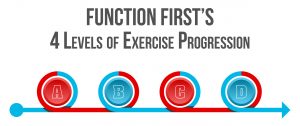We have one of our Level D correctives from the PFMS library that is part of our educational website. Level D exercises are what I refer to as “top of the foodchain” in the corrective exercise world.
These highly integrated exercises carry extensive value beyond the biomechanical integrations. For some clientele, the Level D is the immediate segue to their more traditional fitness workout. For others, the Level D is an element of a workout itself.

Get more like this with your FREE 24 Hour Pass to the Function First Academy
Functional Purpose:
Improve Frontal/Transverse Plane Spinal Alignment
Biomechanical Outcomes:
• Momentum from desired pelvic list promotes lateral spinal flexion, which is enhanced throughout the vertebral column when torso and righting reflexes resist maintaining a level orientation to the horizon.
• Arm overhead act as an extension of the rib cage, creating a longer lever and greater mass to ensure that all vertebrae contribute to the lateral spinal flexion.
• Maintaining a pure frontal plane motion with thoracic extension counters any rotational tendencies of the torso.
• Slight rotation of the intervertebral joints are coupled with lateral flexion of the spine.
• Lateral trunk musculature on the lengthening side are eccentrically loaded & decelerate mass of the trunk in the side bend, then transition concentrically to return trunk to the vertical.
Neurological | Physiological Outcomes:
• Promotes connective tissue elasticity associated with dynamically loading / stabilizing sagittal, frontal and transverse plane motions of the thorax.
• Increase connective tissue compliance and resiliency through the promotion of tissue extensibility, amplifying the viscoelastic and force closure demand to uphold lumbar spine integrity and stability.
• Extensibility of the lateral hip musculature to allow for and additional hip adduction, flexion and internal rotation.
• Elicit a heightened somatosensory response due to the simultaneous bottom-up (lateral lunge) and top-down (lateral flexion / thoracic rotation) influence.
Psycho | Social Outcomes:
• Establish a multidimensional environment involving the neural-networks associated with managing heightened emotional states (anxiety, hyperviligence, etc) during the execution of a complex, autonomic motor task.
Modifications:
• Begin pre-positioned w/ both hips abducted, greatly reducing ground reaction forces.
• Remove ipsi-lateral glenohumeral abduction.
Contraindications:
• Subacromial impingement syndrome.
• Inability to control multi-segmental deceleration of descending body weight.